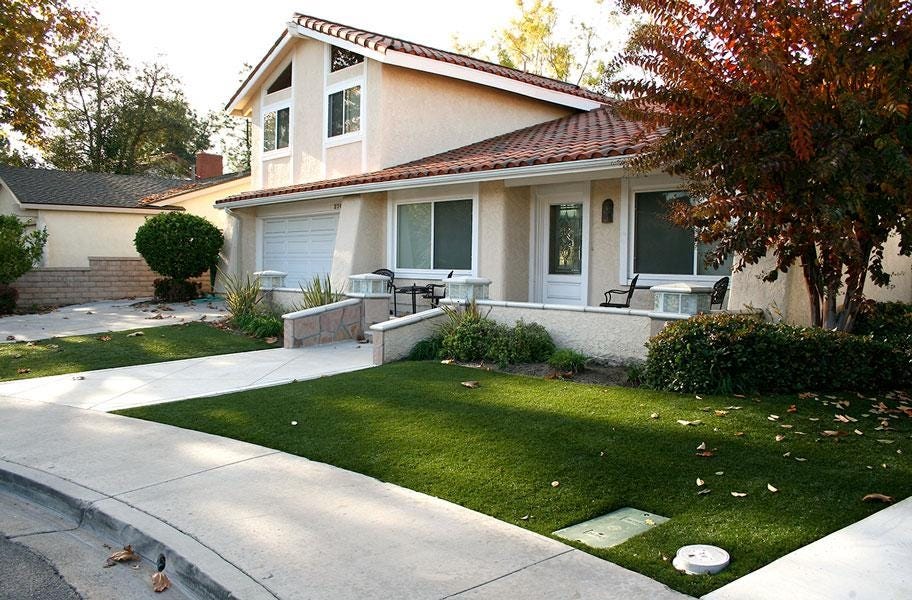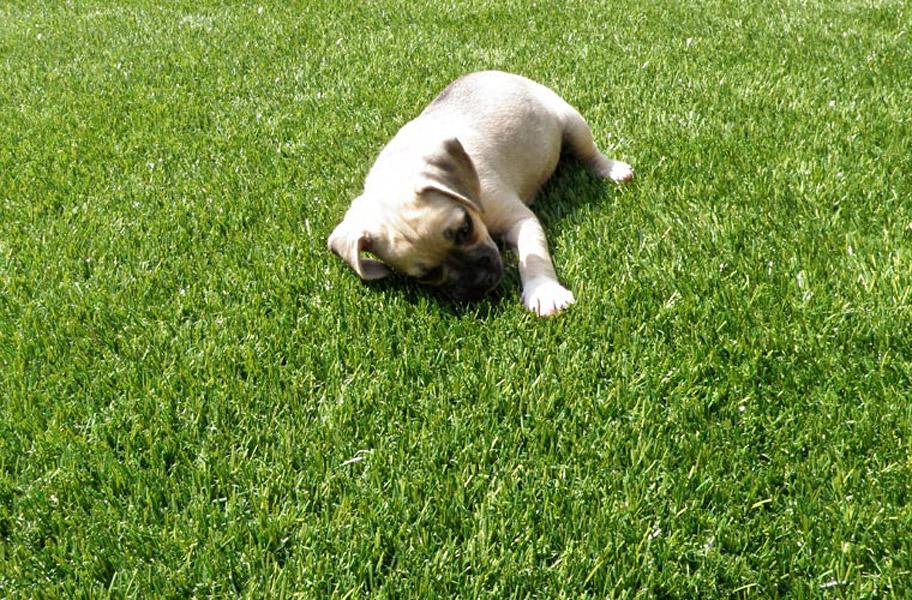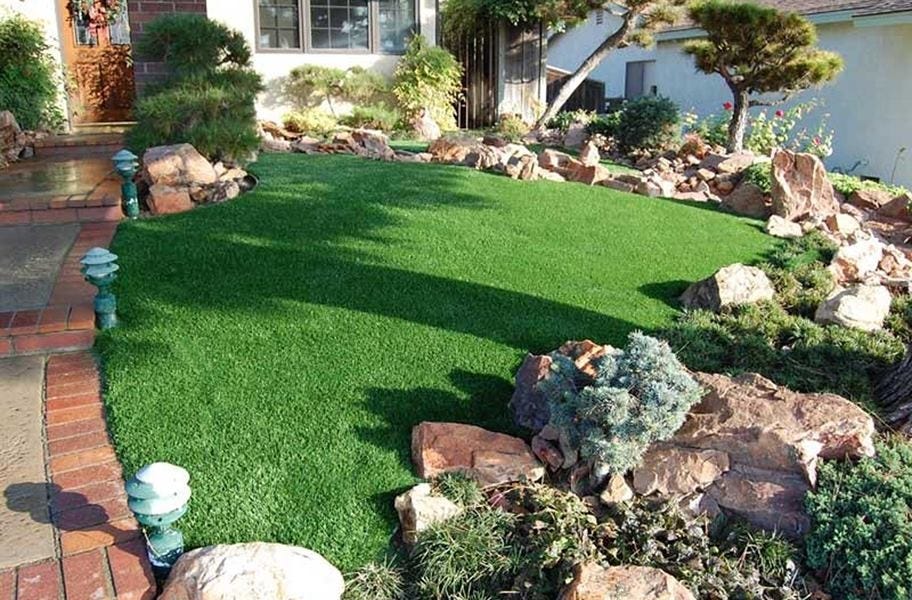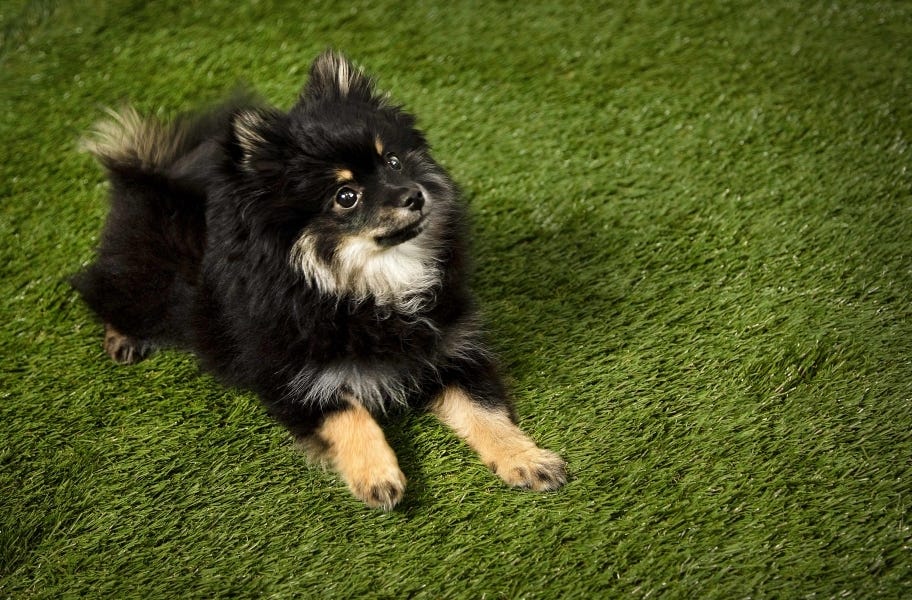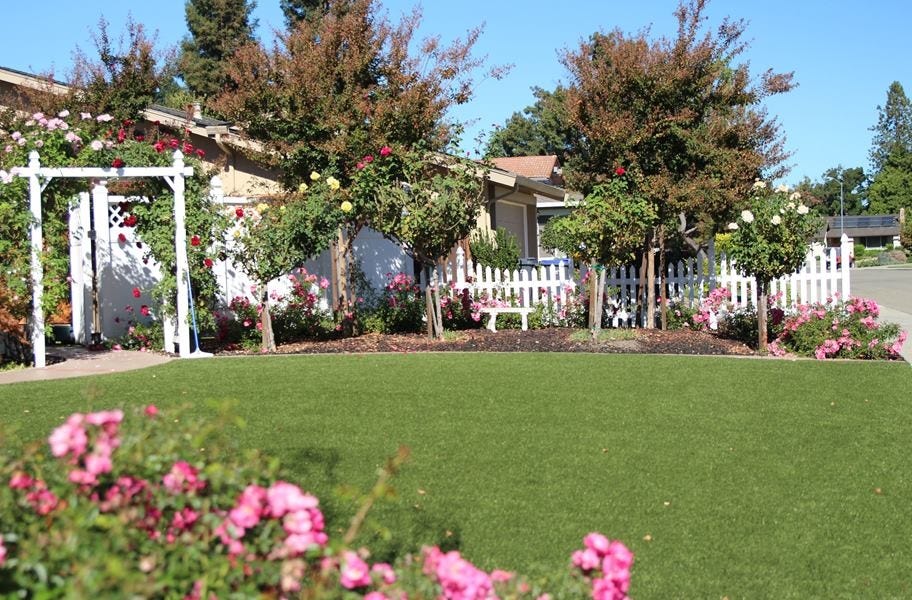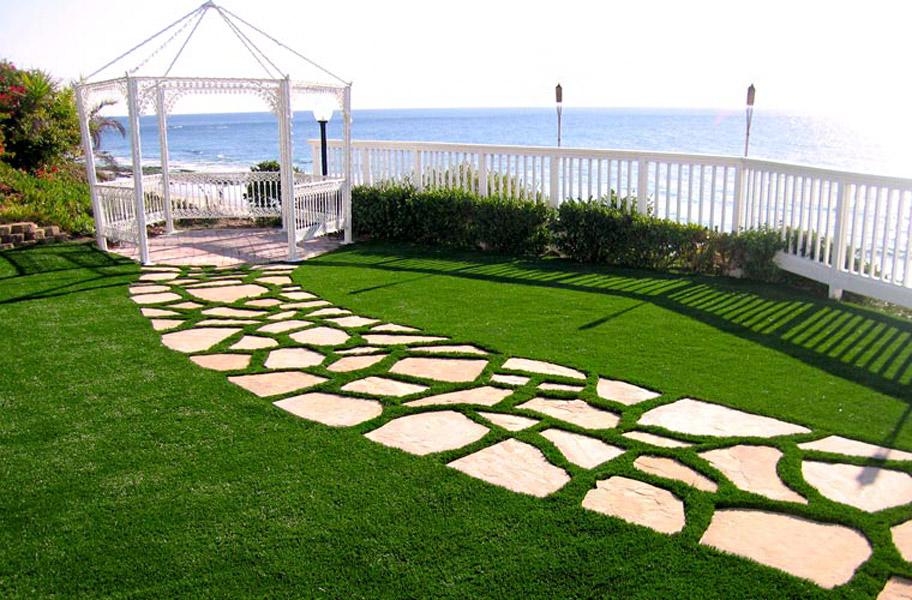
Thinking about artificial grass for your yard or home gym? You probably have some questions. To help you out, we’ve made this artificial grass FAQ, so you can learn everything you need to know and shop with confidence.
In this guide, you’ll get answers to the most common questions about artificial grass, including the different types of turf, how to install it, and how much it costs. Let’s get started.
| Related Content >> About Artificial Grass |
What is Artificial Grass? Learn the Basics
Artificial grass is a synthetic grass alternative made from durable fibers like nylon, polyethylene, or polypropylene. Most artificial grass is built to withstand the outdoor elements. It’s heat-resistant, frost-resistant, and UV stable (meaning it won’t fade in the sun).
While popular for landscaping and sports fields, artificial turf is way more versatile than just that! You’ll find turf as flooring in gyms, doggy daycares, playgrounds, and even as putting green turf. Artificial grass comes in rolls, tiles, and rugs.
Is Artificial Grass Better than Natural Grass?
Artificial grass is better than natural grass in terms of maintenance. It doesn’t require watering, mowing, or trimming, which saves you time and money in the long run. Plus, it won’t attract bugs and other pests, and there’s no mud or dirt for you to accidentally track into your home.
If sustainability is important to you, natural grass might have a slight edge since synthetic grass is made from plastic. However, it’s also important to remember that artificial grass doesn’t need to be watered, which can save thousands of gallons of water each year.
Why Should You Choose Artificial Grass?
Artificial grass is growing in popularity thanks to new hyperrealist looks and heavy-duty, durable materials. But those aren’t the only benefits. Here are even more reasons why you should choose artificial grass.
- No bugs: Outdoor pests don’t like artificial turf as much as the real thing. That means bugs and other creepy crawlies will pack it up and take their nuisances elsewhere.
- No watering: Avoid the huge water bills and muddy spots that result from watering your lawn. Fake turf doesn’t need it!
- Always green: Say goodbye to ugly brown spots, dead patches in the winter, and wilting lawns during droughts. It’s all beautiful greenery all the time.
- No mowing: Lawn maintenance is a huge hassle, right? You can eliminate all those chores for good.
- Long-term savings: Yes, the initial costs are more expensive than natural grass. But artificial turf will save you tons of money over time, with lower water bills and no need for a lawnmower.
- Appearance: These days, artificial grass blades resemble real species, so the look and texture are incredibly convincing. In fact, sometimes it’s hard to tell if it’s not the real thing.
| Related Content >> Best Artificial Grass Options |
Is Artificial Grass Safe?
Artificial grass is non-toxic, made from pet-friendly, kid-friendly nylon or plastic materials. In the past, there have been concerns about the crumb rubber infill used with turf for sports fields, but extensive testing has shown that the recycled rubber is not a carcinogen. Plus, you don’t even have to use crumb rubber in the first place! You have a ton of options that we’ll talk more about below, so stay tuned.
Is Artificial Grass Bad for the Environment?
Artificial grass is eco-friendly in many ways. It’s good for the environment because it saves water and doesn’t need to be mowed. Many turf products are also made of recycled materials.
Artificial turf isn’t completely sustainable, though. The plastic in turf is a petroleum-based product. Also, while it can be made from recycled plastic, turf isn’t biodegradable.
| Related Content >> Landscape Turf Buying Guide |
What is Artificial Grass Made Of?
Artificial turf is made of plastic fibers or nylon. Manufacturers keep coming up with newer and better materials all the time. Here are the most common turf fibers:
- Nylon: Nylon is the most durable fiber used to manufacture turf, and it comes with a Class 1 fire rating for added safety. However, it fades in direct sunlight, so it’s not a good choice for outdoor turf. It’s also abrasive, which can be an issue if you fall or slide on it.
- Polypropylene: It won’t fade in direct sunlight, and it’s softer and less abrasive than nylon. You get comfort and durability in a single package. However, it’s not always given a Class 1 fire rating, and it’s not as durable as nylon.
- Polyethylene: Made from recycled plastic bottles, polyethylene is both eco-friendly and more affordable than nylon or polypropylene. It’s the softest choice of all, and it doesn’t fade in direct sunlight. Because it’s so soft, it will need a high face weight to handle more traffic.
What are the Different Uses of Artificial Grass?
How do you want to use your fake grass? There are tons of specialized options designed for optimal performance in a variety of spaces, from putting greens to playgrounds and even doggy daycares.
Check out your options to find the perfect match!
- Pet-friendly turf: Artificial grass for dogs features a soft pile that is comfortable for precious paws. Our pet-friendly turf resists staining and damage from digging.
- Landscape turf: To better resemble the look and feel of real grass, these rolls resemble a variety of grass species. Some even contain brown thatch for a more realistic look.
- Gym turf: Gym turf is made with a short pile that’s ideal for sled pulls. It’s incredibly durable and can withstand the challenges of commercial gyms.
- Sports and field turf: Designed with sports in mind, field turf is developed to reduce injuries while providing a smooth playing surface with optimal traction.
- Playground turf: Get turf dense enough to handle a high level of traffic. To truly make our artificial grass playground safe, you will want to add a foam pad underneath the turf.
- Putting green turf: You’ll need a short, dense pile that allows a golf ball to roll true. No bad lies on this putting green!
Related Content >> How to Install Artificial Grass
What is Artificial Turf Face Weight?
Artificial grass face weight refers to the weight of one square yard of turf. Turf with more densely-packed fibers and a heavy-duty backing will have a higher face weight.
Most people have never heard of the term face weight, but it is one of the most important factors because it determines the durability of your grass. The higher the face weight, the more durable your grass will be.
What is Artificial Grass Infill?
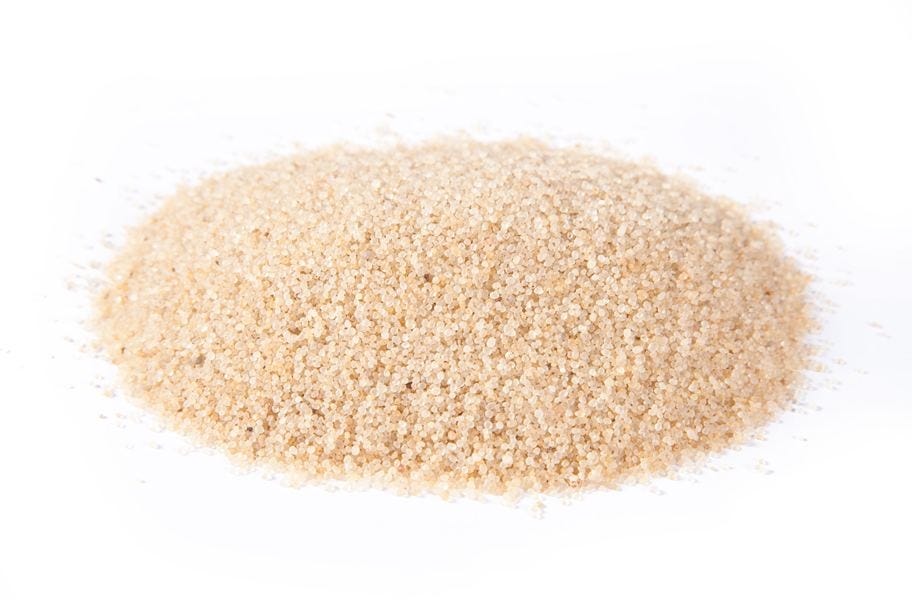
Infill is the filler material used to weigh down turf and make the blades stand up straight. This creates a more natural, less matted look. But infill is essential for more than just looks! Infill protects the lower layer of your turf where the blades connect to the backing sheet.
Rubber crumb is the most common infill, but there are plenty of options beyond that. Some come with specialized features, like odor-resistance and even cooling technology.
Depending on how you plan to use your turf, you may find that a more specialized infill will suit you. The best part is that you can always mix and layer infill to get the benefit of multiple options.
| Related Content >> How to Maintain and Clean Artificial Grass |
Artificial Grass Infill Options
- Crumb rubber infill: Rubber infill is the most popular and common infill used for landscaping, athletic turf fields, and more. It adds bounce to your turf, which helps to reduce athletic injuries. The downside is that it heats up a lot in the sun.
- Silica sand: This is the cheapest infill option, and the second most widely used. Sand tends to be cooler in direct sunlight than rubber. It also eliminates some odors naturally. The downside is that it’s very abrasive.
- Durafill / EnviroFill: Though they have different names, Durafill and EnviroFill are the same things. This infill is made from manufactured sand with rounded edges. This makes it safer for kids to play on, and it’s slightly better at shock absorption than regular sand.
- Hydrochill: Hydrochill (a.k.a. Chill fill) is designed to cool your turf and prevent it from getting too hot in the sun. It’s made from sand with a special coating that promotes evaporative cooling. Just spray the turf down and enjoy the refreshing coolness.
- Putting green infill: Putting green infill tends to be a finer mesh version of Durafill. This is like fine sand that’s small enough to fit into all the small crevices of putting green turf. This ensures a smooth roll every time.
- ZeoFill / zeolite max: Zeolite infill (a.k.a. Zeofill or Zeolite Max) is the best infill to use to help eliminate pet waste smells. It’s a natural material that’s pet-safe. Zeolite is also very porous which helps to keep your turf cooler in direct sunlight.
| Related Content >> How to Choose Turf Infill |
How to Install Artificial Grass
Artificial grass is easy enough to install that many people choose to make it a DIY project. In four simple steps, you can completely transform the look of your lawn. It saves you some money on installation, and of course, you get the bragging rights to say you did it yourself.
Install artificial grass on your own:
- When installing turf over the ground, start by spreading out weed fabric. To install over concrete, you can add turf padding for improved safety and comfort.
- Roll out the turf over the installation area. If you have multiple rolls, tape or staple the edges together.
- Trim the outer edges of the turf and fasten them with nails or adhesive as appropriate.
- Finally, spread infill over the surface to weigh it down. Rake the surface so the blades stand up and create a more natural look.
Essential Installation Accessories
Make your project a success by starting with the right tools and materials!
- Weed fabric: Nobody wants weeds poking through the lawn. You’ll need to lay this down first.
- Lawn pads: For some extra cushion under your feet, lay down a lawn pad. These are fall height rated for safety, so they’re a must-have for playgrounds.
- Staples: Staples hold together the seams between multiple turf rolls.
- Turf seam tape: If you don’t want staples, you can always use seam tape.
- Nails: Nails hold the edges of the turf down.
- Infill: Infill helps hold your turf down and keeps the blades standing up for a natural look.
Where Can You Install Artificial Grass?
Lots of people want to know what surfaces you can install artificial grass over. Good news: We’ve got the answers!
Can artificial turf be laid on concrete or paving slabs?
You can install artificial grass over concrete and paving slabs. For extra cushioning and comfort, you can always lay down a lawn pad before installing the turf.
If you’re installing it outside, make sure the concrete or paving has proper drainage. Additionally, ensure there are no major cracks or dips in the concrete because this can eventually cause damage to the turf.
Can artificial grass be placed over grass?
It’s not a good idea to place artificial turf over existing grass, because you can run into issues with drainage and it won’t be completely level. Plus, some of the weeds and grass underneath will attempt to grow up through your artificial turf.
Instead, you should either cover the natural grass with sand or dig it up to provide a smooth surface for your artificial grass.
Can artificial turf be laid on decking?
Yes, it’s possible to install artificial grass over decking, and lots of people do it! In fact, there are now special artificial grass deck tiles designed specifically for this purpose. Grass deck tiles go right over your existing decking, and they’re just as easy to install as composite decking.
If you want to install a turf roll or rug, that’s an option, too. In this case, you may want to use a lawn pad to level out the surface and add some extra cushioning.
| Related Content >> Pet Turf Buying Guide |
How to Take Care of Artificial Turf
How Do You Clean Artificial Grass?
To keep artificial turf clean and beautiful, you should rinse it off regularly to remove dirt and dust. Raking takes care of leaves and other debris, and can also keep the blades upright and natural-looking by “blooming” the turf. For larger messes like pet waste, pick up the mess, then hose down the area and let the water drain. You can also apply a turf deodorizer if needed.
Can Artificial Grass Melt?
Artificial grass can melt in extreme conditions because it is made from a kind of plastic. According to Jill Odom of Total Landscape Care, “Most synthetic turfs have a melting point of around 175-200 degrees Fahrenheit.”
Obviously, sunlight can’t reach those temperatures on its own, but when that radiation reflects off low-emissivity glass (Low E) windows, it’s easy to reach a temperature that can melt plastic.
To prevent this, you can buy anti-glare windows or add more shade to the area.
What is the Difference Between Indoor and Outdoor Artificial Grass?
The fiber material is the main difference between artificial grass for outdoor vs. indoor use. While some materials are tough and durable, they don’t hold up well in the elements. Still, these less outdoor-friendly products come with their own benefits, and that’s why we still use them indoors.
- Indoor turf: Indoor turf is typically going to be made from nylon, which can withstand high-traction sports and cleats. The only big downside is that it fades in direct sunlight. This kind of grass excels as a covering for patios, gyms, indoor fields, and more.
- Outdoor turf: Outdoor turf can handle the elements, no problem. Made from fade-resistant polypropylene or polyethylene, outdoor turf goes just about everywhere: putting greens, sports fields, playgrounds, landscaping, and more.
Artificial Grass Cost
How Much Does Artificial Grass Cost?
According to HomeAdvisor, artificial grass costs “$2 to $8 per square foot” in 2021, “depending on the brand and type you choose.” Typically, artificial grass with a higher face weight or thickness will be more expensive. Additionally, smaller artificial grass rugs will often cost more per square foot than the larger artificial grass rolls.
How Much Does it Cost to Install Artificial Turf?
If you want to hire someone to install artificial grass for you, it will range from $5 to $20 per square foot, according to HomeAdvisor. The installation cost will be higher if you have a larger area.
Please note: This estimate doesn’t include the cost of installation materials like infill, weed fabric, and any extra labor required to prepare the installation area.
Conclusion
And there you have it! Now you know everything you need to know about artificial grass. You’ve got the facts, so you can shop with confidence and find the perfect artificial grass for you.



